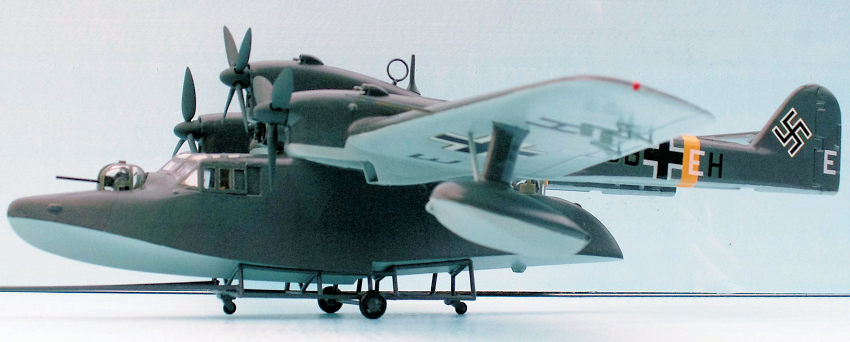
Supermodel 1/72 BV-138C
| KIT #: | 10-017 |
| PRICE: | 95 Danish Kroner when new |
| DECALS: | Three options |
| REVIEWER: | Torben Plesberg |
| NOTES: | Decals partly home-made |

| HISTORY |
The Blohm & Voss Bv-138 reconnaissance flying boat was built between 1939 and 1943 for the Luftwaffe. It is a plane comparable with the American PBY Catalina as a flying boat. The “Seedrache” (sea-dragon) was powered by three Junkers Jumo 205 two stroke diesel engines. Because of the modest power of this engine, it was necessary with three engines. The configuration of the Bv-138 is unique: A central flying boat fuselage, a wing with twin booms and engines as a C-119, and with a third engine on the top of the fuselage above the wings. The plane earned some nicknames: “flying clog” because of its peculiar look, and in Denmark during the German occupation it was known as “Anders And (= Donald Duck). Not because it looked like the famous cartoon figure, but the sound of its engines reminded of the voice of Donald Duck – when he is angry!
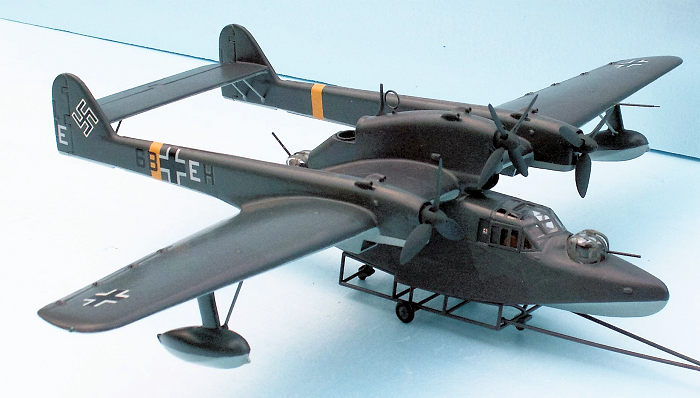 The Blohm & Voss construction
became a success in the end, however, the first prototype was not even able to
get airborne from the water. The German technicians solved the problem by
redesigning the fuselage and making it 20% longer and replacing the gull wing
with a normal wing. The construction revealed to be too weak for operations in a
rough sea, and the aircraft was continually reinforced until at last the C
version was strong enough to fulfil all expectations. Remarkable was that the
center engine had a four bladed propeller with normal blades and the outer
engines had three bladed propellers with very broad blades. I guess the choice
of propeller blades has something to do with the characteristics of the Jumo 205
engine. A normal propeller would not be able to absorb the full power from the
modest revolutions of the diesel engines, if they should be operated in an
economical mode.
The Blohm & Voss construction
became a success in the end, however, the first prototype was not even able to
get airborne from the water. The German technicians solved the problem by
redesigning the fuselage and making it 20% longer and replacing the gull wing
with a normal wing. The construction revealed to be too weak for operations in a
rough sea, and the aircraft was continually reinforced until at last the C
version was strong enough to fulfil all expectations. Remarkable was that the
center engine had a four bladed propeller with normal blades and the outer
engines had three bladed propellers with very broad blades. I guess the choice
of propeller blades has something to do with the characteristics of the Jumo 205
engine. A normal propeller would not be able to absorb the full power from the
modest revolutions of the diesel engines, if they should be operated in an
economical mode.
The Donald Duck was armed with two power-operated turrets with 20 mm guns, one in the nose in front of the cockpit, and one on the dorsal behind the center engine. Furthermore there was an open 7.9 mm MG mounting one floor up just behind the center engine. Three 110 lbs. bombs could be carried under the starboard center wing.
The Bv-138 was used extensively
in Denmark during WWII. There were sea bases at Aalborg, Copenhagen and at
Svaneke on the isle of Bornholm in the Baltic. The Donald Duck was the best
known German aircraft in Denmark. Danish aviation historian Søren C. Flensted
has made a survey called the “Air War over Denmark and Surrounding Waters”.
According to this survey, in the least 26 times a Bv-138 either crashed or made
a forced landing in Danish waters. There was one particular event, when “Anders
And” made a forced landing in one of the lakes in central Copenhagen. The Danish
plastic-kit guru, Wilhelm Willersted, was a ten year old boy at that time. He
and a friend were playing, when they heard and saw the Donald Duck coming in
very low. The boys immediately fired at the aircr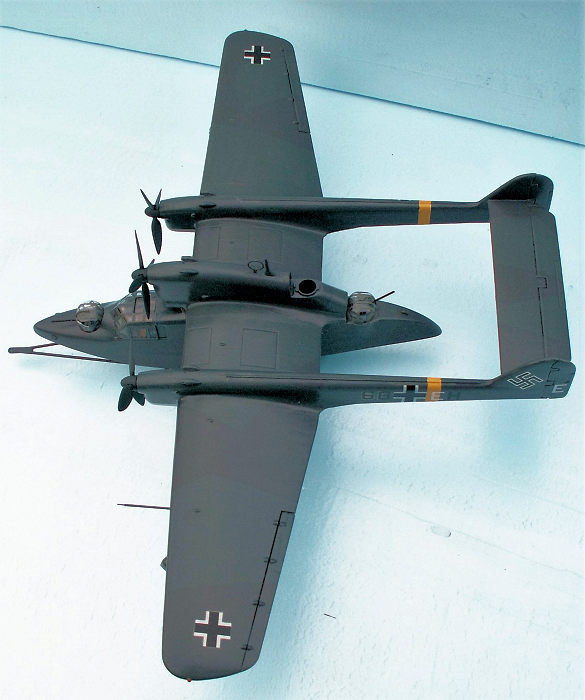 aft with their sticks (MGs!).
And when they heard the aircraft crash, the boys ran away thinking, that they
were responsible for the shooting down of Donald Duck! This event took place on
the 12th of May
1944. The aircraft was a Bv-138 B with the serial no 2009. The aircraft was
totally destroyed, killing a crew member and a pedestrian who was walking at the
bank of the lake.
aft with their sticks (MGs!).
And when they heard the aircraft crash, the boys ran away thinking, that they
were responsible for the shooting down of Donald Duck! This event took place on
the 12th of May
1944. The aircraft was a Bv-138 B with the serial no 2009. The aircraft was
totally destroyed, killing a crew member and a pedestrian who was walking at the
bank of the lake.
Another incident took place in the harbor of Copenhagen on the 11th of August 1943. Bv-138 serial number 31057 had engine troubles and made a forced landing in the harbor. During the landing the aircraft hit a fishing vessel and one person fell into the water and almost drowned. He was, however, lucky and was picked up just in time, and he recovered at the hospital. There are photos of this aircraft from the newspapers of the 12th of August, and the codes of the aircraft are easily readable: 6B + EH, the E being white and also to be seen on the rudder. This machine is the subject of my model. The Luftwaffe unit is quoted as: 1. Erg. Kü. Fl. St., meaning first reserve squadron of the “Küstenflieger” (Coastal Command).
After the war in August 1945, The RAF made a great airshow at Kastrup Airport near Copenhagen. More than 200.000 people watched the show. My father remembered especially an American P-61 Black Widow in the static display, because it was all black and very large. The RAF showed Spitfires, Tempests (Pierre Clostermann’s Squadron!), and Mosquitos. The highlight of the airshow was a couple of Mosquitos making an attack with rockets against a Donald Duck, which was moored in the sound of Øresund close to the airport. The rockets did their job, and the BV-138 disappeared from the sea. Many years later the wreckage was found, salvaged and is now on permanent exhibition in the Technical Museum at Helsingør (Elsinore) – the only Bv-138 to be seen in the world to-day. It would probably not be possible to restore the aircraft, and certainly not to flying condition. An interesting detail: The main spar of the wing is tubular, and is also a fuel tank.
| THE KIT |
The Supermodel kit was released
in 1977 and is the only game in town for a 1/72 scale model. It comes in a large
– and fragile – box with a drawing of a flying Bv-138 on the lid. On the bottom
there are drawings showing the color schemes of the three optional aircraft to
model. And there is a color guide, however, without reference to any color
brand. There are three large sprues in a light grey styrene, and one smaller
sprue with the transparencies. The parts are with raised panel lines and
practically no rivets. Since it is a flying boat there is a small beaching dolly
with the contour lines of the central bottom of the fuselage for a safe
transport out of the water. The decal sheet offers three options, one of these
is the mine sweeping variant, the Bv-138 MS. The degaussing ring comes with the
kit as well. T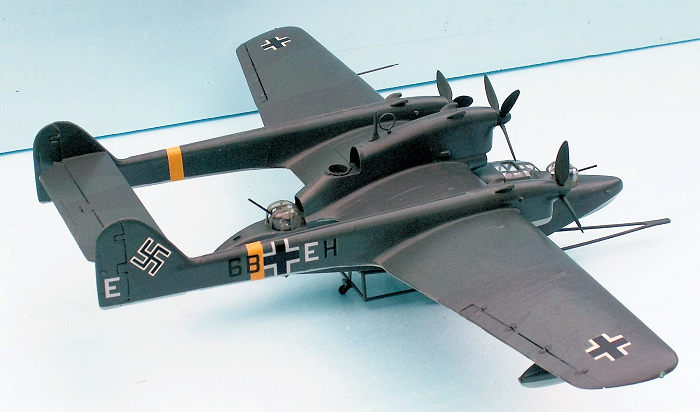 he instructions is a large sheet to fold out. There are a short
story of the Bv-138 in four languages, a survey of the sprues with numbers of
the parts, and nine exploded views showing how to put the model together.
he instructions is a large sheet to fold out. There are a short
story of the Bv-138 in four languages, a survey of the sprues with numbers of
the parts, and nine exploded views showing how to put the model together.
Most of the parts fit well together with some exceptions: The booms need some sanding to be married to the wings (52 - 55), and the bottom pieces of the fuselage (44-45) fit rather badly and need some filling and sanding. The three small bombs have large sink marks and so has the crew members. The eight circular windows for the fuselage are too bad – sink marks in the center. The side windows for the canopy have two frames, but should have three if they are supposed to fit the model. The three bladed very broad bladed propellers seem too clumsy, and might need to be filed thinner. The propeller units should be assembled first – and then put in place into the nacelles. This is actually an ingenious way of getting the propellers in place, meaning that this can be done as the very last operation to finish the model. The interior is modest, but under the canopy there is what one would expect to see. The raised panel lines are far too dominating and should be sanded down – or completely away. I would not waste my time by scribing new panel lines, in this small scale they are so thin that they are practically invisible!
| CONSTRUCTION |
If you follow the instructions, you will end up with a nice model of the Bv-138. However, it is not an easy build. Before the assembly of the fuselage halves, the interior must be assembled and painted. The two turrets must be finished complete with guns and frames painted. The circular windows must be glued in place – or replaced by 2 mm strong slices of 3.5 mm gauge acryl rod, if you want windows without sink marks. It is difficult to assemble the fuselage and get the two turrets correct in place! I failed my first attempt, the front turret tilted to the left. It was out of the groove! With a chisel I opened the nose exactly in the bond, and a 2 mm opening was enough to get the turret into the groove, and the nose was glued together again. Now the turret was correctly in place and I was happy again.
As said marrying the booms to
the wings takes a lot of filing, sanding and filling. I used the following
pr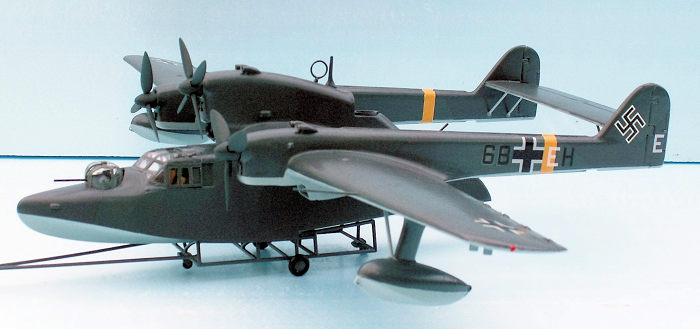 ocedure to marry the wings to the fuselage and the booms to the tail plane:
First I glued the backboard wing with boom to the fuselage being very careful to
fix the wing exactly, where it should be. Now you have to glue the starboard
wing and the tail plane in place simultaneously. If you manage to get the wing
correct to the fuselage, you will have no problem with the tail plane. A small
clamp pressing the booms tight to the tail plane is a good idea.
ocedure to marry the wings to the fuselage and the booms to the tail plane:
First I glued the backboard wing with boom to the fuselage being very careful to
fix the wing exactly, where it should be. Now you have to glue the starboard
wing and the tail plane in place simultaneously. If you manage to get the wing
correct to the fuselage, you will have no problem with the tail plane. A small
clamp pressing the booms tight to the tail plane is a good idea.
The rest of the construction is a matter of getting the details in place. The canopy fits well in the front, not so well in the rear. However, the small cracks will be filled by the paint, eventually an extra layer at the cracks. The side windows are difficult to get in place, if they are closed. It might be because these windows should be broader with three frames. I made some new and broader windows with three frames of 1.5 mm acryl plate, and these were easy to get in place – closed. The propeller assembly is ingenious, because you can finish the model completely, and put the propeller units in place as the very last operation – maybe apart from the four small supports for the tail plane.
The very broad propeller blades of the outer engines seem a bit clumsy. They need some filing to get the blades thinner – and not so clumsy. The four bladed propeller is OK as it is. Only the Bv-138 C has the very broad propeller blades on the outer engines. Early versions of the Donald Duck has more normal looking 3 bladed propellers for all three engines. This is to consider, if you do the mine laying version. Some sources say that the mine layers all were the B version, others say that only the C version was modified as mine layers. Take your pick!
| COLORS & MARKINGS |
The Bv-138 has a standard color
scheme for Luftwaffe seaplanes: Undersides RLM 65 light blue grey and upper
sides a splinter camouflage consisting of RLM 72 green and RLM 73 dark green.
The booms have a yellow RLM 4 band just behind the Balkenkreuz marking. This
band should be 6 mm broad. All colors were Model Master, acrylics (RLM 65 & 4)
and enamel (RLM 72 & 73). Interior color was RLM 02 grey.
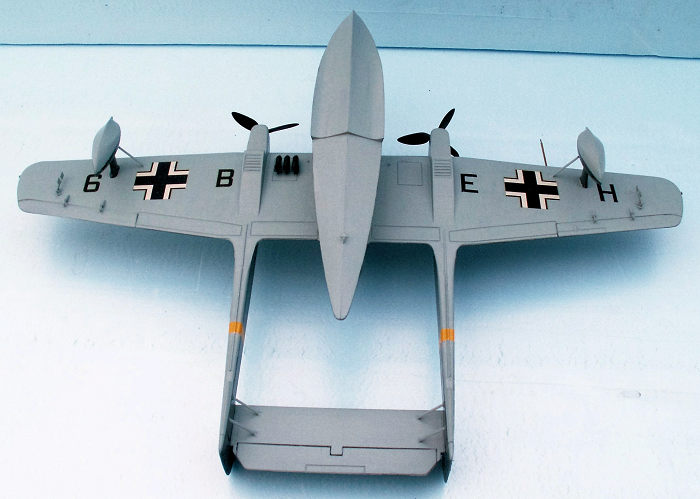 Since the splinter
camouflage of the fuselage has some pointed shapes. I found it necessary to mask
off for the dark green color. The small raised lines of paint along the tape was
removed by water sanding, grain 1200. This process destroyed partly the nice
finish of the enamel paints. However the whole airplane would get a last layer
of satin cote after the decaling.
Since the splinter
camouflage of the fuselage has some pointed shapes. I found it necessary to mask
off for the dark green color. The small raised lines of paint along the tape was
removed by water sanding, grain 1200. This process destroyed partly the nice
finish of the enamel paints. However the whole airplane would get a last layer
of satin cote after the decaling.
Before decaling all spots to be decaled got a layer of gloss clear varnish. The decal sheet offered the six Balkenkreuz and two swastikas for the model. The code letters for my model should be: 6B + EH. The decal sheet offered 6, B and H for the booms and 6 and B for the wing markings. I had to produce four white E letters for the booms and rudders, and a large black E and H for the wing. In my decal stocks I found a small piece of white decal paper, large enough for the four E’s. These were each made of four pieces, which were “assembled” on the model. I also found a piece of black decal paper (from 1962!), and the large E an H were cut as finished letters. The ancient decal paper worked well, however, it took about 3 minutes from the soaking in water and till the letters could be applied on the model.
The two green camouflage colors of the Bv-138 are both rather dark, and on a black & white photo, it is not easy to distinguish the two colors from each other. That is why the Bv -138 often appears as painted in one very dark color on photos from the war years.
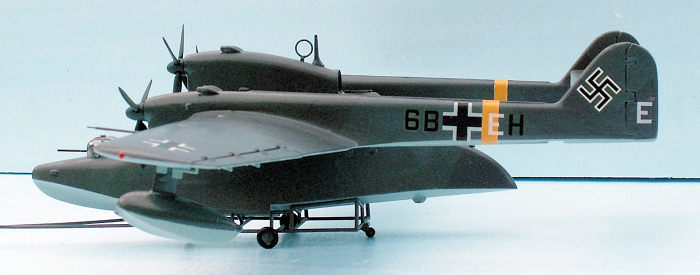 Some modelers talk about
“scale-colors”, and they mix white into all the colors, they use for their
models. If you compare a photo of a scale-colored model with a photo of the
original, there is no doubt about the fact, that the model has got some WRONG
colors! The philosophy is that models often appear too dark compared to full
scale aircraft. Well, the light from the sun is about 500 times stronger than a
60 or 80 Watt bulb. This the only reason why models might seem darker than
originals. (One of the reasons your editor uses a 200 watt bulb and
direct lighting for model photos) After sunset the originals may also seem too dark – they just need
some white color mixed in the paint to appear lighter!
Some modelers talk about
“scale-colors”, and they mix white into all the colors, they use for their
models. If you compare a photo of a scale-colored model with a photo of the
original, there is no doubt about the fact, that the model has got some WRONG
colors! The philosophy is that models often appear too dark compared to full
scale aircraft. Well, the light from the sun is about 500 times stronger than a
60 or 80 Watt bulb. This the only reason why models might seem darker than
originals. (One of the reasons your editor uses a 200 watt bulb and
direct lighting for model photos) After sunset the originals may also seem too dark – they just need
some white color mixed in the paint to appear lighter!
| CONCLUSIONS |
It was an interesting and challenging job to do the “Donald Duck”. This was my second “Donald Duck”. The first one was a C-119 G of the Royal Norwegian Air Force, look for review here. Modelers have built thousands of Messerschmitt 109s and Fw-190s, and many of them probably do not even know this very special reconnaissance flying boat, which was known by every child in Denmark during the Second World War. The kids did not need to see the aircraft, the mere sound of it was enough for a safe recognition. A famous Danish author has described his experience with the Bv-138 during the German occupation in a novel thus:” I heard the sound of the stupid diesel engines of Anders And.” The kit is warmly recommended, even if it is not an easy one to build, and certainly not for beginners.
| REFERENCES |
Sources: Wikipedia: Article “Blohm & Voss Bv-138”
William Green: War Planes of the Second World War, vol. five – Flying Boats
Macdonald & Co, Publishers Ltd. London W. 1 - 1962
Søren C Flensted: Airwar over Denmark and surrounding waters 1939-1945
(Article on the internet)
13 February 2017
Copyright ModelingMadness.com If you would like your product reviewed fairly and fairly
quickly, please
contact
the editor or see other details in the
Note to
Contributors. Back to the Main Page
Back to the Review Index Page
Back to the Previews Index Page